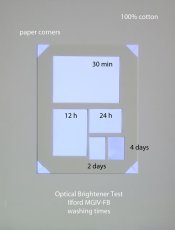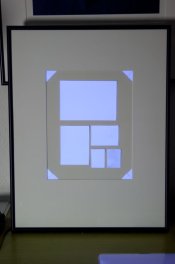RalphLambrecht
Subscriber
In another thread on APUG, a statement was made that extended washing of fiber-based papers can lead to a loss of optical brighteners in the paper. I conducted a test with Ilford MGIV-FB to find out how long it takes and if it has an effect on normal and overnight washing. Here are my results.
An unexposed 5x7-inch piece of Ilford MGIV-FB paper was processed normally (dev, stop and fix) and washed for 30 minutes. Then the piece was cut in half, one side dried and the other washed again, repeating the process until a washing sequence of 30 mn, 12h, 24h, 2 days and 4 days was achieved.
The paper samples were dried and mounted next to each other under glass. A UV source was used to test for remaining optical brightener in the paper. As you might know, optical brighteners work by absorbing invisible UV radiation and re-emitting the energy as light in the visible region of blue light.
The results are shown in the attached photograph. No loss of brightener was detected for 24 h of washing. After 2 days of washing a minor loss of brightener was measurable, and after 4 days of washing a very obvious blue stain appeared. I'm not quite sure of the reason but suspect a reaction between the slightly rusty paper weight and the paper. Now sign of any baryta break was seen in any of the samples.
My conclusion is that there is no harm to wash this fiber-based paper for extended times up to at least one day.
An unexposed 5x7-inch piece of Ilford MGIV-FB paper was processed normally (dev, stop and fix) and washed for 30 minutes. Then the piece was cut in half, one side dried and the other washed again, repeating the process until a washing sequence of 30 mn, 12h, 24h, 2 days and 4 days was achieved.
The paper samples were dried and mounted next to each other under glass. A UV source was used to test for remaining optical brightener in the paper. As you might know, optical brighteners work by absorbing invisible UV radiation and re-emitting the energy as light in the visible region of blue light.
The results are shown in the attached photograph. No loss of brightener was detected for 24 h of washing. After 2 days of washing a minor loss of brightener was measurable, and after 4 days of washing a very obvious blue stain appeared. I'm not quite sure of the reason but suspect a reaction between the slightly rusty paper weight and the paper. Now sign of any baryta break was seen in any of the samples.
My conclusion is that there is no harm to wash this fiber-based paper for extended times up to at least one day.













